Lykoi Cats are a new breed of cat which were founded in 2011.
What makes these cats unique are their characteristics. They have been nicknamed the wolf or werewolf cat, because of their appearance.
There is a lack of fur around the eyes, nose and muzzle which forms a mask.
That, combined with their wedge-like shaped faces and peculiar type of fur, gives them the appearance of a wolf.
In fact, they range from partially hairless to hairy, but the aspect that gave them their name, their facial features, don’t change.
This new breed wasn’t the result of genetic cross-breeding but occurred naturally.
They are the result of a natural gene mutation.
The breed name was chosen because Lykoi means wolf in Greek.
Contents
Why We Love Lykoi Cats
Although most of the time they look like something another cat has dragged in, they have proved to be curious, friendly, and affectionate.
Every day is a bad hair day for Lykoi.
They seem to have been caught in a downpour and then a hurricane or escaped from a lab where they do genetic experiments.
Despite that, they interact well with humans and even other animals.
They have been described by owners as tender and with some curious dog-like qualities.
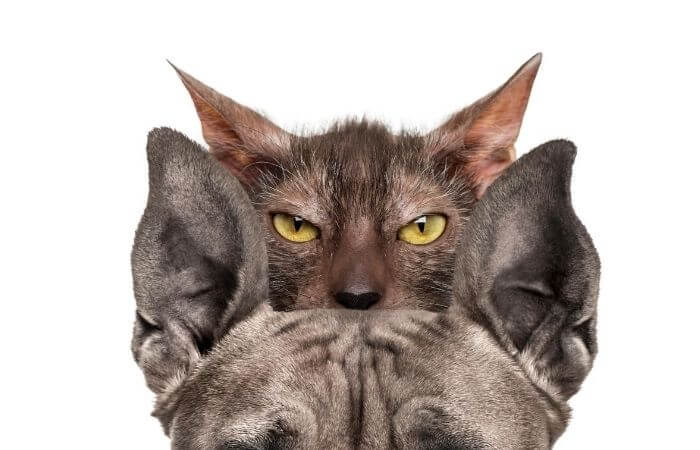
They seem to be pack hunters, not lone stalkers.
Only don’t leave them to babysit your pet fish or hamster!
As well as their distinctive look which endears them to humans, Lykoi cats have an excellent temperament.
They are very intelligent cats who love to problem solve and play games. But they also like their own company.
They will happily play alone if you leave them with some toys and they also love to just sit and observe as much as they love to indulge their curiosity.
They will familiarise themselves with every tiny corner of the house.
Another reason to love them is they like to be petted on your lap (but not for too long as they have a low boredom threshold) and their sociable nature means they mix very well with other pets.
Feeding
Feeding these cats doesn’t seem to be a problem.
They will eat the same cat food that any other cat will eat, and the breeder claims that they aren’t fussy eaters.
But it does well to remember that there is ongoing research into this new breed to understand what potential health problems they might be prone to, so it is best to stick to safe options when it comes to food.
Wet cat food is the most recommended, but you can happily switch between wet food and dry kibble to ensure that kitty gets the full range of nutrients it needs.
If you are going to prepare and dish up your own food, be sure it contains at least 70% protein from a quality, natural source and limit the carb content (like any cat too many carbs will lead to weight gain).
Always introduce new foods gradually and always ensure kitty has a supply of freshwater.
Description
Apart from being described as wolf-like, they have also been called scary, sinister, and cartoon character cats.
In other words, scabby cats!
Like they have been copied from an animated or horror film.
Denizens of dark and murky alleyways.
Their fur, which looks thin and wiry, is in actual fact very soft.
Although they seem skinny, their bodies are slim, but also compact.
Lykoi are generally classed as a small to medium breed.
They are described as energetic and intelligent, very active, and playful.
Are Lykoi Cats Hypoallergenic?
As all cats produce allergens. If you are sensitive to them, you are bound to suffer, even if you are a cat-loving person.
As yet Lykoi cats don’t have the reputation of being any worse than the average cat in this regard.
According to popular belief, it is cat fur that brings on the allergies, but in fact it is something scientifically classified as FEL D1 which is the culprit.
It is found in a cat’s saliva. After they have groomed themselves, the saliva dries and then becomes airborne, which increases the chance of inhaling it.
Frequent grooming of your cat, washing its toys and bedding will lessen the risk, whether your cat is Lykoi or not.
Grooming
Grooming a Lykoi is slightly easier than grooming most cats as they don’t have an undercoat of fur.
Use a soft cat brush, always moving in the direction of fur growth. Brushing should be done twice a week except when your Lykoi is moulting when it is advisable to brush daily.
You can bathe Lykoi cats – if they will let you.
Always use a cat-grade shampoo, never one designed for humans.
If your cat doesn’t like water, there are dry shampoo formulations for cats available.
Other grooming is to check ears regularly for wax and dirt build-up. Ears can be cleaned with a soft damp cloth or a cotton bud (use with care).
Your cat’s teeth should be brushed to maintain oral hygiene.
There are plenty of options in cat toothbrushes and toothpaste readily available.
Claws should also be trimmed regularly.
Origins
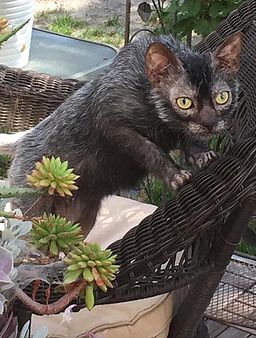
Lykois came about when veterinarian John Gobble and his wife Brittney, adopted some kittens from a rescue shelter in Vonore, Tennessee.
Concerned by the appearance of some of the kittens, the couple conducted various medical examinations without finding any signs of illness.
At first, John and Brittney thought the cats they’d got from the shelter had picked up the Sphynx cat or Devon Rex gene somewhere along the line, so they had the kittens DNA tested.
The results were that their cats had absolutely no relation with those genetic lines whatsoever.
Their conclusion was that the cats were a result of a natural genetic mutation.
John Gobble then deliberately mated one of the kittens with a black female cat and the natural mutation reoccurred.
They were presented with a litter of strange-looking cats that are now named Lykoi.
So, a new breed was born and one that was not bred by cross mating.
The Gobble’s eventual five Lykoi cats, known as the Foundation Cats, were registered with the International Cat Association.
It was then found that the mutation had cropped up in other places too. Feral Lykoi cats have been discovered in more than five widely spread states in the USA.
The cats first arrived in Britain in 2016.
Lifestyle
Lykoi’s love the treats and comforts you give them.
They like to prowl, to come and go as they please. Lykois, although curious, with an adventurous streak, are essentially house cats.
They like human company. So, if your lifestyle tends towards being out of the house most of the day, maybe a Lykoi cat isn’t the best for you.
Health Concerns
So far, owners and breeders haven’t found any great health issues among these cats and they have the lifespan of a regular cat – 13 to 15 years.
These are definitely house cats and being susceptible to the cold, they are always seeking warmth.
It is very doubtful that they would survive as feral cats, especially in colder climates.
Susceptibility to hypothermia is a very real issue for Lykoi cats.
There has been some concern about oil build-up on their skin that could leave them vulnerable to ear infections and mites, but nothing has come of that as yet.
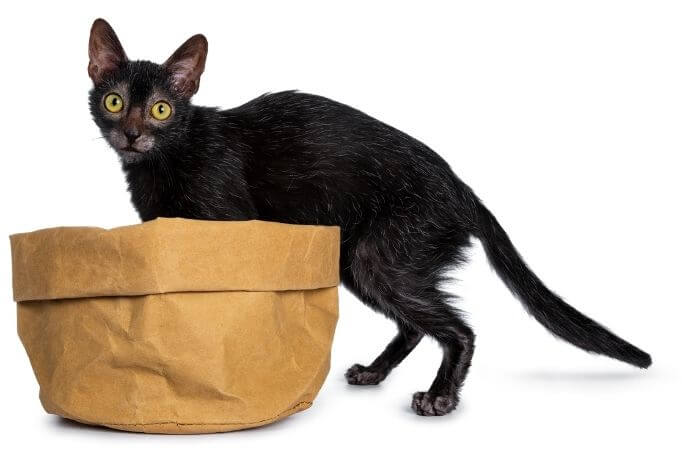
This can be controlled by regular bathing.
The other factor that may concern owners is their moulting, which they seem to do frequently.
This isn’t a sign of ill health, but part of their genetic make-up. This happens on a seasonal basis.
Their fur tends to fall out in tufts, giving them that scabby appearance, but it always grows back again.
When they are born their fur is black, but after a few weeks it starts to fall out, but when it grows back it isn’t always black again.
Some of these cats end up with a salt and pepper coat.
Something to remember is that the moulting can cause large bare patches so if your cat goes out in the daytime, it is a good idea to apply a sunblock.
Another odd thing about Lykoi cats is that they don’t have an undercoat. Researchers that have tested their DNA say that is the result of a genetic mishap in their hair growth codes that took place during the mutation.
Adopting A Lykoi
Adopting a Lykoi Cat isn’t really an option as there are so few of these cats that none have wandered off, escaped, or have been thrown in the street to end up in animal rescue centres.
Despite the reports of them turning up in feral cat colonies, they are few and far between.
Also it is doubtful that the average person would actually recognise the breed, they would probably just think that are undernourished alley cats.
They can be bought, but as yet are very expensive.
Prices for these cats can range from between $1500-$2,500. It takes two Lykoi cats to produce litters.
Lykoi Breeders
Although the breeding of Lykoi cats started some ten years or so ago.
They have become popular with breeders in the United States and there are believed to be seven official breeders registered with the International Cat Association.
On a global scale, breeders are scattered all over the world, as far apart as France, Canada, and South Africa.
In the UK it is estimated that there are only between 50-100 Lykois so far.
Lykois are also recognised by the American Cat Fanciers Association.
Here are a few Lykoi Breeders:
Conclusion
If you are fed up with cute, then these may be the cats for you.
They don’t look mean, like a cat version of a nightclub bouncer, but they do project another kind of scariness.
They look like some wicked witch’s familiar, come up from the underworld.
Fortunately, appearances can be deceptive, as their owners will tell you.
Unfortunately, the wait to get one may be long, as avid cat lovers are queueing up to get one.
As an Amazon Associate I may earn a small fee from qualifying purchases at no extra cost to you. This helps us run the site, so thanks for your support!

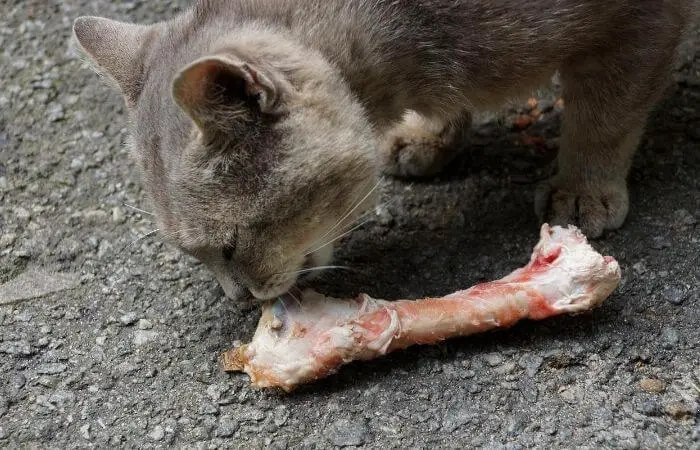
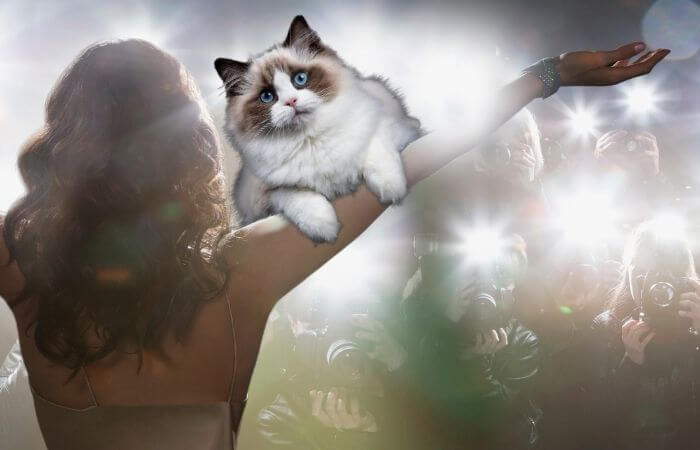
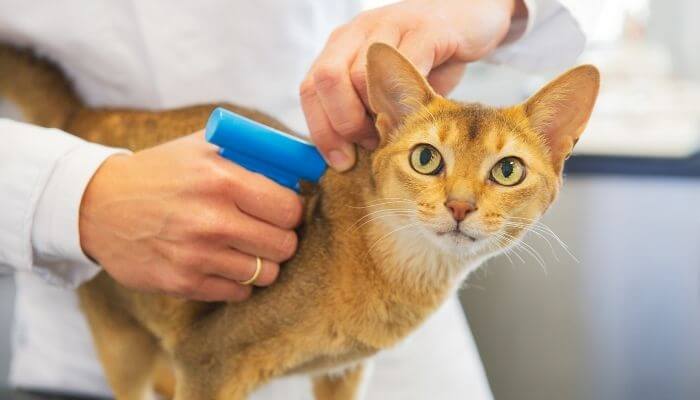
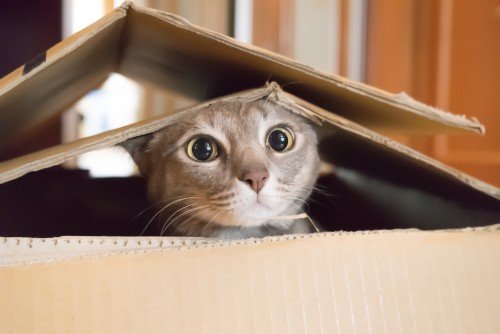
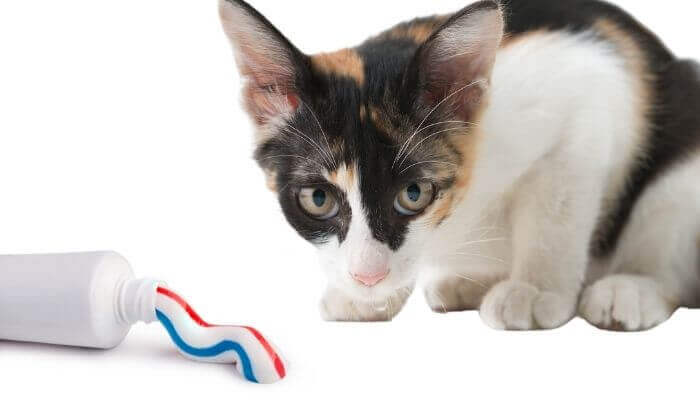
Leave a Comment